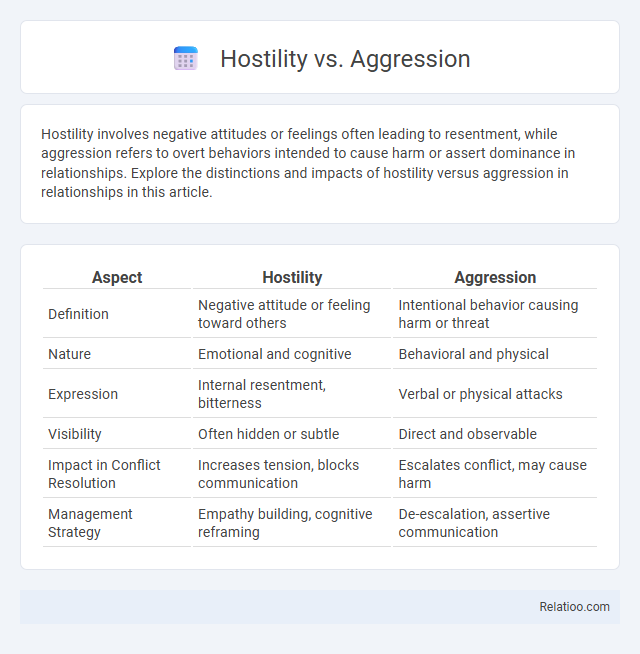Hostility involves negative attitudes or feelings often leading to resentment, while aggression refers to overt behaviors intended to cause harm or assert dominance in relationships. Explore the distinctions and impacts of hostility versus aggression in relationships in this article.
Table of Comparison
| Aspect | Hostility | Aggression |
|---|---|---|
| Definition | Negative attitude or feeling toward others | Intentional behavior causing harm or threat |
| Nature | Emotional and cognitive | Behavioral and physical |
| Expression | Internal resentment, bitterness | Verbal or physical attacks |
| Visibility | Often hidden or subtle | Direct and observable |
| Impact in Conflict Resolution | Increases tension, blocks communication | Escalates conflict, may cause harm |
| Management Strategy | Empathy building, cognitive reframing | De-escalation, assertive communication |
Understanding Hostility: Definition and Characteristics
Hostility is defined as an enduring attitude of antagonism and resentment characterized by negative beliefs and feelings toward others. It differs from aggression, which involves overt behaviors intended to cause harm, while hostility primarily relates to internal emotional states and cognitive processes. Understanding hostility involves recognizing its role as a risk factor for aggressive acts and its impact on social interactions and mental health.
Defining Aggression: Key Concepts and Features
Aggression is defined as behavior aimed at causing harm or pain to others, often driven by anger or frustration and manifesting in physical, verbal, or relational forms. Key features of aggression include intent to hurt, response to perceived threats, and varying expressions ranging from hostile aggression, which is impulsive and emotion-driven, to instrumental aggression, which is deliberate and goal-oriented. Distinct from general hostility, aggression involves overt actions, while hostility primarily refers to underlying negative attitudes or feelings.
Hostility vs Aggression: Core Differences
Hostility refers to an internal state of ill will or anger, often characterized by negative attitudes and feelings toward others, while aggression involves external behaviors intended to cause harm or assert dominance. You can experience hostility without displaying aggression, but aggression typically manifests when hostility translates into actions such as verbal abuse or physical violence. Understanding these distinctions is crucial for accurately addressing conflicts and managing emotional responses.
Psychological Roots of Hostility
Hostility, aggression, and anger are interconnected but distinct psychological states, each with unique origins and manifestations. Hostility often stems from deep-seated psychological roots such as unresolved trauma, chronic stress, or perceived threats to your self-esteem, leading to persistent negative attitudes towards others. Understanding these underlying causes is crucial for managing hostility effectively and preventing it from escalating into overt aggression.
Biological and Environmental Factors Behind Aggression
Aggression is influenced by a complex interplay of biological factors such as genetics, neurotransmitters like serotonin and dopamine, and hormonal levels including testosterone, which modulate aggressive behavior in humans and animals. Environmental factors such as early childhood experiences, exposure to violence, social stressors, and cultural norms also shape aggressive responses by affecting brain development and emotional regulation. Distinguishing aggression from hostility involves recognizing aggression as overt physical or verbal behavior, whereas hostility represents an internal negative attitude or feeling, both of which are modulated by overlapping but distinct biological and environmental mechanisms.
Types of Hostility and Their Manifestations
Types of hostility include passive-aggressive behavior, overt anger, and covert resentment, each manifesting through distinct emotional and physical cues. Your understanding of these manifestations--such as silent treatment in passive hostility, verbal outbursts in overt aggression, and subtle sabotage in covert resentment--enables better recognition and management of interpersonal conflicts. Differentiating these types helps in addressing the root causes of hostility versus outright aggression for more effective conflict resolution.
Forms of Aggression: Physical, Verbal, and Relational
Forms of aggression manifest primarily in three types: physical aggression involves bodily harm or threats such as hitting or pushing; verbal aggression includes hostile language, insults, or threats aimed at damaging self-esteem; relational aggression targets social relationships through exclusion, spreading rumors, or manipulation to undermine an individual's social standing. Hostility, often underlying these behaviors, represents a persistent negative attitude or emotional state towards others, while aggression refers to the actual behaviors or actions intended to harm. Understanding these distinctions aids in identifying and addressing the varied manifestations of aggressive conduct.
Impact of Hostility and Aggression on Mental Health
Hostility and aggression significantly impact mental health by increasing stress levels, anxiety, and depressive symptoms. Persistent hostility can lead to chronic inflammation and heightened cortisol production, worsening psychological well-being. Aggression often exacerbates social isolation and interpersonal conflicts, intensifying feelings of anger and emotional distress.
Strategies for Managing Hostility and Aggression
Effective strategies for managing hostility and aggression emphasize de-escalation techniques, such as active listening and maintaining calm body language, to prevent conflict intensification. Implementing cognitive-behavioral interventions helps individuals recognize triggers and develop healthier emotional responses, reducing future incidents of hostile or aggressive behavior. Environmental modifications, including structured routines and safe spaces, also play a critical role in minimizing stressors that can provoke hostility or aggression.
Cultivating Healthy Relationships: Reducing Hostility and Aggression
Reducing hostility and aggression is essential for cultivating healthy relationships by fostering open communication and empathy, which diminish misunderstandings and conflict escalation. Implementing conflict resolution techniques and practicing emotional regulation help individuals manage impulses that lead to aggressive behaviors and hostile attitudes. Encouraging positive interactions and mutual respect reinforces trust and cooperation, creating a supportive environment that minimizes negativity and strengthens bonds.

Infographic: Hostility vs Aggression
 relatioo.com
relatioo.com